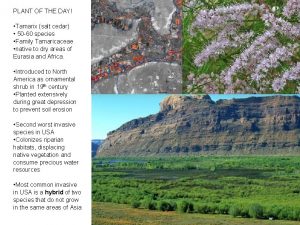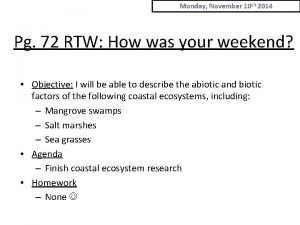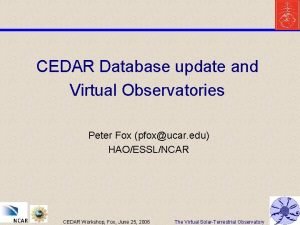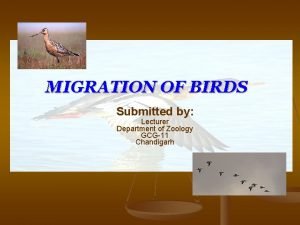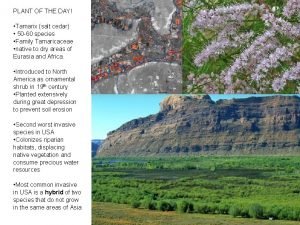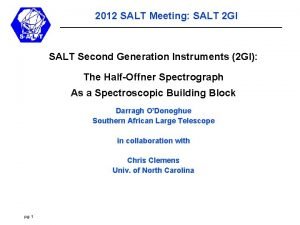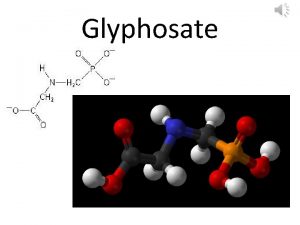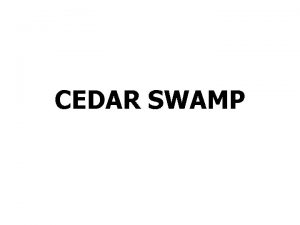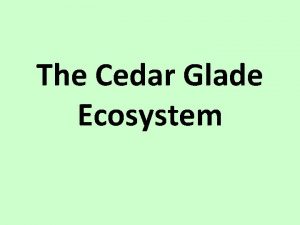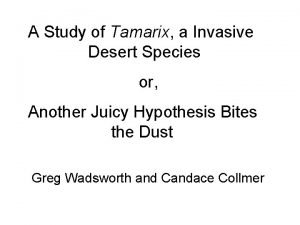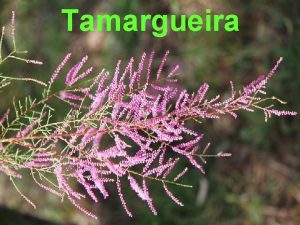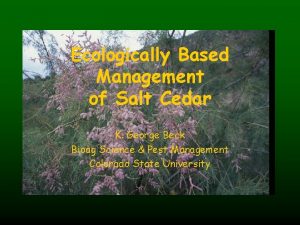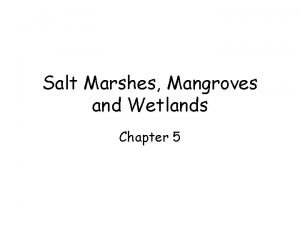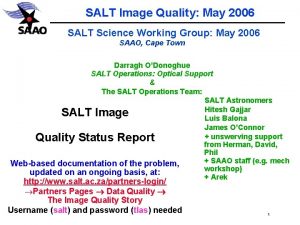PLANT OF THE DAY Tamarix salt cedar 50























- Slides: 23

PLANT OF THE DAY! • Tamarix (salt cedar) • 50 -60 species • Family Tamaricaceae • native to dry areas of Eurasia and Africa. • Introduced to North America as ornamental shrub in 19 th century • Planted extensively during great depression to prevent soil erosion • Second worst invasive species in USA • Colonizes riparian habitats, displacing native vegetation and consume precious water resources • Most common invasive in USA is a hybrid of two species that do not grow in the same areas of Asia

Hybrid Speciation

Kinds of Hybrid Speciation Homoploid Hybrid Speciation • Rare • Reproductive isolation difficult to achieve 2 x X 2 x reproductive isolation 2 x Polyploid Hybrid Speciation (Allopolyploidy) • Common • Reproductive isolation byproduct of genome doubling 2 x X 2 x reproductive isolation 4 x

Model for Homoploid Hybrid Speciation Interspecific hybridization Fertility / viability selection Stabilization of fertile & viable hybrid segregates Reproductive isolation facilitated by karyotypic divergence (recombinational model) hybrid trait causes ecological divergence hybrid trait causes assortative mating spatial isolation

Recombinational Model New homokaryotype confers partial isolation with parentals

Frequency of Hybrid Speciation Hybrid speciation Hybrid Speciation Modelavailable (open habitat available for hybrids) (open habitat for hybrids) • Fertility controlled by two underdominant loci performance controlled by two loci with additive 0. 4 effects Alex Buerkle • Three different proportion of replicates • Ecological 0. 5 0. 3 habitats and ecological selection occurred at 0. 2 seedling stage 0. 9 0. 7 fertility of F 1 hybrid 0. 1 0. 5 0. 3 0 0. 1 0. 3 0. 5 0. 9 0. 7 Heredity (2000) 84, 441– 451 ecological selection

Ecological Selection Decay of genetic distance (Gst) between hybrid species and one of its parental species

Hybrid speciation Frequency of Hybrid Speciation Alex Buerkle Ecological Selection (no open habitat available for hybrids) 0. 9 0. 7 0. 5 0. 3 0. 1 0. 3 0. 5 0. 7 0. 9 F 1 Hybrid Fertility Stable Hybrid Zone Adaptive Introgression Hybrid Speciation Buerkle et al. (2003)

CONDITIONS FAVORING HOMOPLOID HYBRID SPECIATION Little spatial isolation between parental species, but substantial isolation of hybrid species. • • Open habitat for hybrid species. Strong ecological selection favoring hybrid lineage in new habitat. • Weak postzygotic isolation between parental species, but strong isolation of hybrid species. • • Hybrid trait causes assortative mating (not modeled)

EMPIRICAL EVIDENCE: SPATIAL ISOLATION (allopatric origin of oxford ragwort, Senecio squalidus (Abbott, 2000, 2002)

EMPIRICAL EVIDENCE: SPATIAL ISOLATION Allopatric: Gila seminude (De. Marais et al. , 1992) Paeonia sinjiangensis (Sang and Zhang, 1999) Senecio squalidus (Abbott et al. , 2000) Parapatric: Argyranthemum sundingii (Brochmann, 1987) Helianthus anomalus (Rieseberg, 1991) Helianthus deserticola (Rieseberg, 1991) Helianthus paradoxus (Rieseberg et al. , 1990) Invasive sculpin (Nolte et al. 2005) Lycaeides butterflies (Gompert et al. 2006) Iris nelsonii (Arnold, 1993) Pinus densata (Song et al. , 2003) Penstemon clevelandii (Wolfe et al. , 1998) Sympatric: Daphnia mendotae (Taylor et al. , 1996) Lonicera fly (Schwartz et al. , 2005) Pungu maclareni (Schliewen & Klee, 2004) Heliconius heurippa (Mavarez et al. 2006)

Helianthus annuus mesic soils H. anomalus sand dune EMPIRICAL EVIDENCE: ECOLOGICAL ISOLATION H P x H. deserticola desert floor H. petiolaris H sandy soils P Reciprocal transplant experiments indicate that synthetic and natural hybrids favored in hybrid habitats. H H. paradoxus salt marsh

TESTING THE IMPORTANCE OF ECOLOGY IN HYBRID SPECIATION Are the stabilized hybrid species ecologically divergent from their parents? YES - for all but one species tested • • Are the hybrid species favored in the hybrid habitats? YES - for Helianthus • Is there evidence of parallel hybrid speciation? YES - for Argyranthemum, Helianthus, Pinus

HYBRID TRAITS CAUSE ASSORTATIVE MATING Helianthus deserticola (flowering time) Rieseberg 1991 H. deserticola desert floor Heliconius heurippa (wing pattern) Maverez et al. 2006 Iris nelsonii (flower color) Arnold 1993 Penstemon clevelandii (flower color) Wolf et al. 1998 Xiphorus clemenciae (swordtail) Meyer et al. 2006 H

EMPIRICAL EVIDENCE: KARYOTYPIC EVOLUTION Distribution of hybrid and parental Helianthus species

Crossing relationships among hybrid and parental Helianthus species Line thickness proportional to % seed set H. deserticola 18. 5% 13. 8% 2. 1% H. anomalus H. paradoxus H. petiolaris % 2. 2% 1. 6 0. 18% 1. 6% 0. 78% % 5 1. 0. 96% H. annuus


Comparative Linkage Mapping - summary Parents H. annuus x H. petiolaris: 8 translocations / 3 inversions Hybrids H. anomalus: H. deserticola: H. paradoxus: collinear with both parents 6 linkages 6 6 collinear with novel gene one parent order 3 linkages 5 4 8 linkages 6 7 24 of 29 new chromosomal changes in hybrid species associated with linkage groups already rearranged in parents (P = 0. 009) Origins of rearrangements 1/3 sorting of pre-existing rearrangements 2/3 novel rearrangements

Conclusions - Homoploid Hybrid Speciation • Generally good match between theory & empirical data spatial isolation of hybrid species predicted & 12/16 hybrid species parapatric or allopatric with parents • Ecological divergence of hybrid species predicted & all but one hybrid species exhibit some degree of ecological divergence • Karyotypic evolution predicted to contribute to reproductive independence of hybrid lineage & 6/14 hybrid species exhibit karyotypic divergence • • Hybrid traits frequently cause assortative mating

How does hybridization create novel or extreme phenotypes? Natural populations of organisms often contain cryptic variation that cannot be predicted from the phenotype of the population. • Cryptic variation is released in crosses through the expression of extreme or “transgressive” phenotypes • Mechanism = complementary gene action

Empirical Evidence: Ecological Divergence Helianthus annuus H. anomalus sand dune mesic soils P H x H. deserticola desert floor H Field Experiments: Hybrid species favored in hybrid habitats H. petiolaris sandy soils P H H. paradoxus salt marsh

Re-creating the birth of a new species in the greenhouse Most extreme traits could be re-created in experimental hybrids 1% of experimental hybrids classified as H. anomalus 6. 5% of experimental hybrids classified as H. deserticola 0. 2% of experimental hybrids classified as H. paradoxus

Conclusions - Transgressive Segregation • • Crosses between genetically divergent populations frequently release cryptic phenotypic variation, referred to as transgressive variation Transgressive segregation may provide a means for large or difficult evolutionary transitions requiring simultaneous changes at multiple genes or traits. This possibility is illustrated by the ecological divergence of several sunflower species. Hybridization’s role in adaptation is probably under-estimated.
 Day 1 day 2 day 3 day 4
Day 1 day 2 day 3 day 4 Salt cedar switch
Salt cedar switch Salt cedar switch
Salt cedar switch Observation of plant growth day by day
Observation of plant growth day by day Day 1 day 2 day 817
Day 1 day 2 day 817 Salt marsh plant adaptations
Salt marsh plant adaptations Cedar point yacht club
Cedar point yacht club Marine stewardship council
Marine stewardship council Cardinal newman college cedar
Cardinal newman college cedar Cedar database
Cedar database Feedback essentials
Feedback essentials Cardinal and cedar waxwing compare and contrast
Cardinal and cedar waxwing compare and contrast Migration in birds ppt
Migration in birds ppt Venn diagram of cardinal and cedar waxwing
Venn diagram of cardinal and cedar waxwing Active shooter cedar rapids
Active shooter cedar rapids Cedar falls public works
Cedar falls public works Cedar crest blue cardinal
Cedar crest blue cardinal Kirkwood my hub
Kirkwood my hub Dalton wild cedar rapids iowa
Dalton wild cedar rapids iowa Cardinal cedar waxwing venn diagram
Cardinal cedar waxwing venn diagram Forbidden frontier cedar point
Forbidden frontier cedar point Cedar park lady timberwolves basketball
Cedar park lady timberwolves basketball Plant introduction in plant breeding
Plant introduction in plant breeding Tronsmo plant pathology and plant diseases download
Tronsmo plant pathology and plant diseases download


